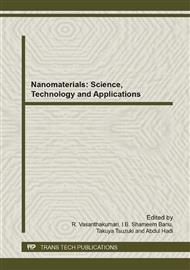[1]
G. Kiriakidis, N. Katsarakis, Photon sensitive high index metal oxide films, J. Phys.: Condens. Matter. 16 (2004) S3757.
DOI: 10.1088/0953-8984/16/35/017
Google Scholar
[2]
K. L. Chopra, S. Major, D. K. Pandya, Transparent conductors- A status review, Thin Solid Films. 102, 1 (1983).
DOI: 10.1016/0040-6090(83)90256-0
Google Scholar
[3]
D. P. Norton, Y. W. Heo, M. P. Ivill, K. Ip, S. J. Pearton, M. F. Chisholm, T. Steiner, ZnO: growth, doping and processing, Mater. Today. 7 (2004) 34–40.
DOI: 10.1016/s1369-7021(04)00287-1
Google Scholar
[4]
N. J. Dayan, S. R. Sainkar, R. N. Karekar, Formulation and characterization of ZnO: Sb thick-film gas sensors, Films. 325 (1998) 254-258.
DOI: 10.1016/s0040-6090(98)00501-x
Google Scholar
[5]
Zhong Lin Wang, Zinc oxide nanostructures: growth, properties and applications, J. Phys.: Condens. Matter. 16 (2004) R829–R858.
DOI: 10.1088/0953-8984/16/25/r01
Google Scholar
[6]
R. Chen, S. W. S. McKeever, Theory of Thermoluminescence and Related Phenomena, World Scientific, Singapore, (1997).
Google Scholar
[7]
Kuo-Feng Lin, Hsin-Ming Cheng, Hsu-Cheng Hsu, Li-Jiaun Lin, Wen-Feng Hsieh, Band gap variation of size-controlled ZnO quantum dots synthesized by sol–gel method, Chemical Physics Lett. 409 (2005) 208–211.
DOI: 10.1109/cleopr.2005.1569477
Google Scholar
[8]
Hsin-Ming Cheng, Hsu-Cheng Hsu, Shiow-Lian Chen, Wen-Ti Wu, Chih-Chun Kao, Li-Jiaun Lin, Wen-Feng Hsieh, Efficient UV photoluminescence from monodispersed secondary ZnO colloidal spheres synthesized by sol–gel method, Journal of Crystal Growth. 277 (2005).
DOI: 10.1016/j.jcrysgro.2004.12.133
Google Scholar
[9]
C. Cruz-Vazquez, F. Rocha-Alonzo, S. E. Burruel-Ibarra, M. Barboza-Flores, R. Bernal, M. Inoue, A new chemical bath deposition method for fabricating ZnS, Zn(OH)2, and ZnO thin films, and the optical and structural characterization of these materials. Appl. Phys. A-Mater. Sci. Process. A. 79 (2004).
DOI: 10.1007/s00339-003-2097-5
Google Scholar
[10]
S. Bhushan, D. Diwan, S. P. Kathuria, Thermoluminescence of ZnO: Pr and ZnO: Gd under UV, β-and γ-ray irradiations, Phys. Status Solidi A. 83 (1984) 605-611.
DOI: 10.1002/pssa.2210830223
Google Scholar
[11]
D. De Muer, W. Maenhout-van der Vorst, Thermoluminescence of ZnO. Powder, Physica. 39 (1968) 123-132.
DOI: 10.1016/0031-8914(68)90053-0
Google Scholar
[12]
D. Diwan, S. Bhushan, S. P. Kathuria, Thermoluminescence of ZnO: Cu, La under UV and γ-ray irradiation, Cryst. Res. Technol. 19 (1984) 1265-1269.
DOI: 10.1002/crat.2170190922
Google Scholar
[13]
E. W. Seelig, B. Tang, A. Yamilov, H. Cao, R. P. H. Chang, Self-assembled 3D photonic crystals from ZnO colloidal spheres, Mater. Chem. Phys. 80 (2003) 257-263.
DOI: 10.1016/s0254-0584(02)00492-3
Google Scholar
[14]
G. Murugadoss, Synthesis, optical, structural and thermal characterization of Mn2+ doped ZnS nanoparticles using reverse micelle method, J. Lumin. 131 (2011) 2216-2223.
DOI: 10.1016/j.jlumin.2011.03.048
Google Scholar


